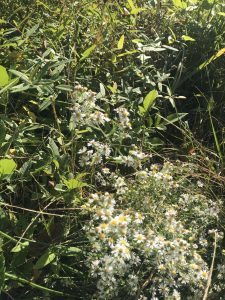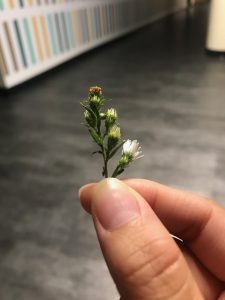October 14, 2019 – 4:05 PM (Time arrived) – 4:36 PM (Time Left)
It finally feels like fall! With the cool weather that we have been experiencing as of recently, I was more excited to come out to my sit-spot knowing that 1) the humidity would not be clinging onto me and 2) there are less bugs flying about to come bite me.
Today’s task was to find a specific organism, that was unknown to us, and identify it. As I explained in my journal entry, I was set on observing a periwinkle colored flower that I had seen the last time I came to visit my sit-spot. Sadly, when I went over to find it, it had already dropped its petals and was not clearly recognizable based on the stem that was left. Instead, I decided to try to identify a white, flowering bush that was nearby.

In relation to my sit-spot, the single bush was about 4-5 yards away towards the NW. Before I had decided on this flower bundle, I noticed that out of all of the open space that I can see and easily navigate about, this was the only large bush that I was able to see. More specifically, it was just past the edge of where the cut grass ends and the long, unkept grasses remain, so the bush was well surrounded.
Now onto identifying this organism. I utilized an app called “Picture This” that allows the user to take a picture of a plant and provide possible species that it could be. I took multiple pictures of the bush in order to have more accurate results. Based on these, the two potential species that it could be were White Heath Aster (Symphyotrichum ericoides) and Frost Aster (Symphyotrichum pilosum). With the pictures and descriptions provided for each by the app, I am not going to lie, I was confused. They both looked identical! I knew that I would have to analyze specific components of the plant carefully in order to correctly identify what it really was.
I first started by looking at the differences between petal shape for both. For the Frost Aster, the petals were narrow and slightly pointed at the tips, while in the White Heath Aster, the petals were slightly wider and more rounded (Bransford and Dolphia 2017). Based on this, the flowers that I was identifying looked more so like the Frost Aster petals.
Next, I looked to see if there were any differences in the bracts (phyllaries) that surrounded the base of the flowers for each kind of species. In white heath aster, the base of the bracts are white then turn green at the tips. The tips also curl back from the base unlike Frost Aster, where they are relatively straighter and more green (Symphyotrichum pilosum (Awl Aster)). Based on these characteristics, my decision was further solidified that the flower bush I was observing was Frost Aster rather than White Heath Aster.


Overall, trying to identify my organism was pretty challenging, simply based on the fact that White Heath Aster and Frost Aster are so closely related and look very similar. There were many times where I second-guessed my decision and had to start over the identification process in order to come to a solid consensus. Despite the challenge and the amount of time and effort taken, the experience was actually pretty fun and I dare say is my favorite activity that we have done for the blogs so far.
References Cited
Bransford, W. D., & Dolphia. (2017, August 18). Plant Database. Retrieved October 14, 2019, from https://www.wildflower.org/plants/result.php?id_plant=SYERE.
Symphyotrichum pilosum (Awl Aster). (n.d.). Retrieved from https://www.minnesotawildflowers.info/flower/awl-aster



That app sounds awesome and really useful!
It’s nice that you found an app to help you with the identification process. I ran into the same problem with second-guessing myself on species because there are lots of similarities!